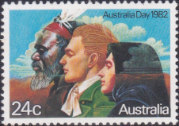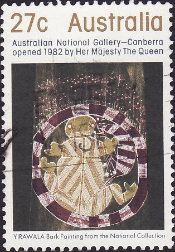History
Timeline results for 1970 to 1999
Found 232 results for your search. Showing page 6 of 12.
Year from 1970, year to 1999
1982
-
Aboriginal people at the Hermannsburg mission (131 km southwest of Alice Springs) are granted freehold title.
-
The Northern Land Council sign an agreement with Pancontinental Mining Limited allowing the company to mine uranium at Jabiluka, 230 km east of Darwin in the NT. The mine site is surrounded by, but not part of Kakadu National Park. World Heritage listed for both its environmental and cultural importance, Kakadu is Australia’s largest national park. In 1998 thousands came from around Australia and across the world to support the Mirarr people and blockade the proposed Jabiluka mine.
-
Death of Joe Pat in Roebourne gaol (WA). The first death in custody to be widely protested ultimately leads to the setting up of the Muirhead enquiry.
-
Mark (Gordon) Ella, an Aboriginal rugby union player, often considered as one of Australia’s all-time greats in that sport, is named Australian of the Year.
-
Eddie Mabo commences land rights proceedings in the High Court of Australia.
-
The National Aboriginal Conference developed its own proposal which created a way for every Aboriginal nation to negotiate its own treaty, compact or agreement and it avoided nations being forced into a single national proposal.
-
Ken Colbung, a Nyoongar Aboriginal activist from Western Australia, receives the Order of Australia Medal for his services to the Aboriginal community. Ken was heavily involved in Aboriginal politics and the main architect of the Aboriginal Heritage Protection Act which came into force in 1972. [1]
-

The Australia Day 1982 stamp tried to convey a sense of unity of diverse Australians. A stamp for Australia Day shows the head of an Aboriginal man, along with that of a European colonist and an immigrant. The stamp's design symbolises the three waves of migration to Australia: Aboriginal people from south-east Asia, the British and European post-war immigrants.
-
The Senate Standing Committee on Constitutional and Legal Affairs is presented with a recommendation that an amendment to the Constitution for the Treaty-making process should be the same form as Section 105A of the Australian Constitution, which would then enshrine Aboriginal inherent sovereign rights. The Fraser government gives in-principle support to this proposal.
-
Queensland Aboriginal people protest at the Commonwealth Games.
-

The stamp shows Gurgurr the Moon man, and his dog Mulutji. Australia Post issues a stamp commemorating the opening of the National Gallery, Canberra. The design shows an Aboriginal bark painting of Gurgurr the Moon man, and his dog Mulutji as they appear on the moon. The artist is not mentioned.
-
Australia Post issues a set of four stamps themed Aboriginal Culture in Music and Dance. It is the first time actual Aboriginal work appears on Australian stamps. All designs show bark paintings of Mimi spirits dancing. The artists are David Milaybuma (27c), Lofty Nabardayal (40c), Jimmy Galareya (65c) and Dick Nguleingulei-Murrumurru (75c).

Mimis are fairy-like beings of Arnhem Land (NT) and have extremely thin and elongated bodies. They live in rock crevices and sometimes taunt people.
1983
-
Aboriginal Land Rights Act (NSW) recognises dispossession and dislocation of NSW Aboriginal people with land tax funding as compensation, and sets up a 3-tiered system of Aboriginal Land Councils (state, regional and local).
-
The Aboriginal Child Placement Principle, developed principally due to the efforts of Aboriginal and Islander Child Care Agencies (AICCAs) during the 1970s, is incorporated in NT welfare legislation to ensure that Indigenous children are placed with Indigenous families when adoption or fostering is necessary. This is followed in NSW (1987), Victoria (1989), South Australia (1993), Queensland and the ACT (1999), Tasmania (2000) and Western Australia (2006).
-
The Senate Standing Committee on Constitutional and Legal Affairs, in its report Two Hundred Years Later, rejects the idea of a treaty because it believes that the Aboriginal peoples were not a sovereign entity and so they could not enter into a treaty with the Commonwealth.
The Standing Committee favours a compact which could eventually be inserted into the Constitution by referendum. (The word "compact" is used here with the meaning of "a formal agreement between two or more parties, states, etc.", or "a contract".)
-
Prime Minister Bob Hawke stops negotiations, withdraws funding from the National Aboriginal Conference and shuts down the treaty process. Aboriginal attitudes to the idea of a treaty are also varied and far from unanimous in the 1970s and 80s.
-
Wesley Lanhupuy (Australian Labor Party), from central coastal Arnhem Land, is elected to the Northern Territory Legislative Assembly representing the electorate of Arnhem.
1984
-
End of various "protection acts", which had existed since 1897 in Queensland. Under these laws Aboriginal people were effectively slave labourers; the wages for their labour were stolen by the State or never even claimed by the State from the employers. The issue of reparation remains unresolved.
-
Lowitja O’Donoghue, a pioneering nurse and future Aboriginal and Torres Strait Islander Commission (ATSIC) chairperson, receives the Australian of the Year award. ⇒ Famous Aboriginal people
-
The National Aboriginal Conference identifies 27 key aspects that were continually emerging in community consultations across this country.
References
View article sources (1)
[1]
'WA mourns loss of Elder', Koori Mail 468 p.14


